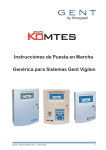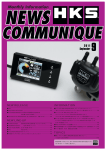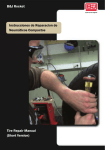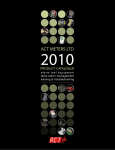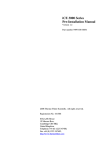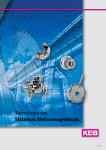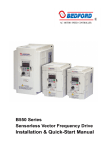Download 7x28AC - Copley Controls
Transcript
Model 7XX8 Digital Brushless Driver FEATURES • MODEL 7228AC 7428AC 7228DC 7428DC DSP controlled torque, velocity, or position mode using encoder feedback from the motor • Windows 98 software • Command sources: VOLTAGE 32~132VAC 32~264VAC 45~186VDC 45~373VDC I-PEAK 20 20 20 20 I-CONT 10 10 10 10 Analog +/-10V inputs Digital PLS/DIR, CW/CCW Digital Presets Data RS-232, RS-485 • • • • • • • • Select up to 16 preset modes using a PLC or Logic Hi/Lo line Programmable S-curve and trapezoidal motion profiles RS-232 or RS-485 digital interface used to store all settings in internal FLASH memory for selecting preset modes Separate motor signal and control signal Sub-D type connectors for simpler cabling Terminals for DC Buss connect to external regenerative energy dissipator Input for motor temperature sensor protects motor No Transformer Required! AC Version operates directly from AC mains, DC Version operates from rectified line, with full optical isolation between signal and power stages. 32~132VAC ( 7228 ) 32~264VAC ( 7428 ) Fault protections: Short-circuits from output to output, output to gnd Over/under voltage Over temperature APPLICATIONS PRODUCT DESCRIPTION The 7XX8 series are DSP (Digital Signal Processor) controlled PWM servo amplifiers from Copley Controls Corp. for control of AC brushless motors that require sinusoidal commutation. 7XX8AC Models operate directly from the AC mains while 7XX8DC Models operate form directly rectified line. All models have full isolation between signal and power stages. No power transformers are required. All models take industry standard ±10V analog control signals for torque or velocity control. In addition, stepper-motor command pulses in CW/CCW, or PLS/DIR format, can be used for position control. External devices, such as sensors or PLC connections, can initiate presets. Presets can include a profiled move to a specific position, a change in tuning parameters, or a complete change in operating mode. Through the 4 preset logic lines up to 16 distinct presets can be initiated. Each driver will contain configuration information stored in nonvolatile Flash Memory on the driver. Through the RS-232 port a single driver can be configured for an unlimited number of axis in a system. The Copley Motion Explorer software, a windows 95/98 visual basic interface, can be used to tune, configure, and analyze the drive. The configuration data can be uploaded and saved to disk for replicated usage. Consequently, the modularity of the 7XX8 driver provides the user with a single spares inventory that can be configured over all the needs of a system. • Linear Brushless Motors • Automated assembly machinery Windows 95/98 & NT DLLs (Dynamic Link Libraries) work with virtually all windows programing languages, including Visual C/C++, Visual Basic, and others. • Packaging Equipment A growing database of motor models and a continuously evolving collection of amplifier operating modes are available as resources for the 7XX8 Driver. 1 Model 7XX8 Digital Brushless Driver Technical specifications Test conditions: 25°C ambient, Load = 400 MODEL H. in series with 1 Ohms. 7228AC 7428AC 20A @ 110V 1 second at peak power. 10A @ 130V 20A @ 205V OUTPUT POWER Peak power Peak time Continuous power 10A @ 250V OUTPUT VOLTAGE On-resistance (Ro, ohms) Max PWM Peak Output Voltage Maximum effective output voltage at continuous power Maximum effective output voltage at peak power 0.2 0.15 ±Vout = (VAC X 1.41 -2)X(0.97) - (Ro)X(Io) 130V @ 10A 250V @ 10A 110V @ 20A 205V @ 20A INPUT POWER Mains voltage Mains current @ continuous output rating Inrush current on startup External mains fuse rating 32~132VAC, 47~63Hz 16A 37A max 20A/125V 32~264VAC, 47~63Hz 16A 37A max 20A/250V MECHANICAL Weight 3.71 lb (1.69 kg) without optional Heatsink. Add 3.2 lb ( 1.47 kg ) for heatsink. 7.50 (190.5) MECHANICAL OUTLINE AC MODEL 0.93 (23.62) 3.00 (76.2) 6.22 (158) 6.94 (176.3) STATUS Model: 7428AC Input: 32~264VAC 50/60Hz 9 5 J4 DATA J1 6 AC H 1 N 2 37 1 19 3 BUSS + 4 MOTOR - 5 U 6 V 7 W 8 J3 SIGNAL 20 1 9 7.00 (177.8) 15 8 J2 MOTOR 9 1 9 15 20 37 6 Westwood, MA, USA 2.72 (69.1) 1.46 (37.08) 4.72 W/ Heat Sink Option (119.9) Heat Sink Option CONNECTORS J1: Power & motor 9-position terminal strip J2: Motor 15-position female Sub-D type. #4-40 standoffs for cable shell lock screws J3: Signal 37-position female Sub-D. #4-40 standoffs for cable shell lock screws J4: RS-232/485 9-position female Sub-D. #4-40 standoffs for cable shell lock screws Connector shells are connected to amplifier chassis for grounding/shielding 2 Model 7XX8 Digital Brushless Driver MODEL 7228DC 7428DC 20A @ 180V 1 second at peak power. 10A @ 180V 20A @ 370V OUTPUT POWER Peak power Peak time Continuous power 10A @ 370V OUTPUT VOLTAGE On-resistance (Ro, ohms) Max PWM Peak Output Voltage 0.2 0.15 ±Vout = (VDC)X(0.97) - (Ro)X(Io) INPUT POWER Mains voltage Mains current @ continuous output rating Inrush current on startup External mains fuse rating 45~186VDC 16A 19A max 20A/125V 45~373VDC 16A 37A max 20A/250V MECHANICAL Weight 2.71 lb (1.23 kg) without optional Heatsink. Add 3.2 lb ( 1.47 kg ) for heatsink. MECHANICAL OUTLINE DC MODEL 7.50 ( 190.5 ) 0.93 ( 23.62 ) 4.91 ( 155.5 ) 3.00 ( 76.2 ) 5.55 ( 138.75 ) Model: 7428DC STATUS Input: 45~373VDC 6 5 J4 1 9 DATA J1 ENAB POL S1 J3 1 SIGNAL 13 25 BUSS 2 - 3 U 4 V 5 W 6 MOTOR 7.00 ( 177.8 ) + 14 7 1 J2 MOTOR 15 2.00 1.00 ( 50.0 ) ( 25.0 ) Heat Sink Option 9 Westwood, MA, USA 4.00 W/ Heat Sink Option ( 100.0 ) CONNECTORS J1: Power & motor 7-position terminal strip J2: Motor 15-position female Sub-D type. #4-40 standoffs for cable shell lock screws J3: Signal 37-position female Sub-D. #4-40 standoffs for cable shell lock screws J4: RS-232/485 9-position female Sub-D. #4-40 standoffs for cable shell lock screws Connector shells are connected to amplifier chassis for grounding/shielding 3 8 1 Model 7XX8 Digital Brushless Driver LOAD INDUCTANCE Minimum inductance Maximum inductance 400 H No maximum. Bandwidth varies with inductance and supply. BANDWIDTH Small signal -3dB @ 2kHz with minimum load at nominal supply voltage. Varies with load inductance and PID filter values. 205uS rate. PWM OUTPUTS PWM frequency Modulation 20kHz Center-weighted, 50% duty cycle at 0V output REFERENCE INPUTS Torque or velocity Position Preset Analog ±10V Differential, 94k Ohms between inputs, ±20V maximum Digital, 2-signal TTL, Any of three formats: CW / CCW; Pulse/Dir; A & B quadrature pulses. Digital, 4 line TTL, 28V max, Group programmable: 22k Ohms internal pull-up to +5V or pull-down to 0V. The four inputs initiate 16 predefined modes. ANALOG TACHOMETER INPUT ±120V or ±20V maximum, Jumper selectable. Load 240k Ohms MOTOR OVERTEMP INPUT Analog input 5k Ohms internal pull-up to +5V, for thermistor or IC sensor. Thresholds programable. MOTOR ENCODER INPUTS A, B, X 2.2k Ohms internal pull-up to +5V. differential or single ended, 4Meg. Counts/Sec maximum. /Enc Buffout A /Enc Buffout B /Enc Buffout X HCMOS, Differential line driver, Buffered encoder output A HCMOS, Differential line driver, Buffered encoder output B HCMOS, Differential line driver, Buffered encoder output X BUFFERED OUTPUTS HALL INPUTS U, V, W, Single-ended, 10k Ohms internal pull-up to +5V LOGIC INPUTS Enable Enables amplifier within 5ms when active. Pos Enable Enables CW rotation. Neg Enable Enables CCW rotation. Reset Resets latching fault condition, recovers in 1ms. TTL, 28V max, Group programmable: 22k Ohms internal pull-up to +5V or put-down to 0V. Software programmable active Lo or Hi. LOGIC OUTPUTS Status output 1, 2 Software function programmable. N-channel MOSFET, 10k Ohms pull-up to +5V, Max. 50V off-voltage, Max. 250mA sink, 5 Ohms On-resistance. STATUS LED Bicolor LED changes color and flashes to indicate amplifier operating status Blinking green = Ready Amplifier OK, will run when enabled Green = Normal Amplifier enabled AND Amp OK (see above) Red = Buss Fault, non-latching Over or under-voltage condition. Amplifier recovers when in normal range Blinking red = Latching Fault, Output overcurrent (short circuit), following error, or overtemp condition. Clear with software control, Ground /Reset, or power amp off/on to clear condition ANALOG MONITOR +/-10V Full scale, 1k Ohms source resistance . Programmable monitor functions. DC POWER OUTPUTS +5VDC @ 250mA, +12VDC @ 25mA, -12VDC @ 25mA 4 Model 7XX8 Digital Brushless Driver DATA PORT RS232 or RS485 jumper selectable. Permits programming parameters from PC. Settings held in flash memory. RS232 3 wire (TxD, RxD, Gnd). RS485 5 wire (XMT+, XMT-, RCV+, RCV-, Gnd) differential full duplex. CONTROLLER GND Floating. Gnd externally. Power stage optically isolated THERMAL REQUIREMENTS Storage temperature range -30°C to +85°C Operating temperature range 0° to 70°C baseplate temperature Thermal resistance (heatplate to ambient): No heatsink or fan: 0.92 deg C/W, no heatsink with fan: 0.51 deg C/W With heatsink: no fan: 0.6 deg C/W; with heatsink and fan: 0.23 deg C/W. PROTECTION Output to output short Output to ground short Overtemperature Undervoltage Overvoltage Current-limiting Latches unit OFF (will reset if /Reset input is wired to ground, or when power is cycled) Latches unit OFF (will reset if /Reset input is wired to ground, or when power is cycled) Latches unit OFF at 70°C on heatplate (will reset if /Reset input is momentarily grounded, or when power is cycled off/on) shutdown at internal DC buss < 45VDC shutdown buss > 195VDC (7228) or buss > 390VDC (7428) Output current peak, continuous, & peak-time limits programmed via RS232 port CE CONFORMITY EN 55011,1992 CISPR 11 (1990) Edition 2/ Amendment 2: Limits and Methods of Measurement of Radio Disturbance Characteristics of Industrial, Scientific, and Medical (ISM) Radio Frequency Equip. Electromagnetic Compatibility Generic Immunity Standard. Safety Requirements for Electrical Equip. for Measurement, Control, and Lab Use. EN 50082-1,1992 EN 61010-1,1993 Recommendations A line filter, such as the Corcom P/N20VDK6, can be installed at least 3 feet from the driver’s power entry terminal strip to reduce line noise. This will reduce the systems line noise for compliance with CE emissions limits. Power supply and motor connections should be made with wire that has a rating to support the amplifiers continuous current. AWG 14 wire will support all amplifiers in this series. Additional recommendations for wire insulation are for a voltage rating of 600V and a maximum temperature of 105°C Fusing should be time delayed and install on any hot lines coming from the mains. The fusing for the high voltage units should be rated for 250VDC at 25Amps and are to be installed on both hot lines. The fusing for the low voltage units should be rated for 120VDC at 25 Amps and is to be installed on the hot line. Signal Board Layout Jumpers Settings JP13 JP3 JP6JP4 A B DSP & Internal Flash RAM 8 7 6 5 4 3 2 LED JP13 JP2 J4 Data Port 8 7 6 5 4 3 2 1 8 7 6 5 4 3 1 Factory installed Do not move RS-232 (Default) JP1 JP3 RS-485 JP1 1 J3 Signal Function J2 Encoder/Hall 5 2 JP2 Tach. Scale (Default) Range +/-20Vmax. JP2 Tach. Scale Range +/-120Vmax. A B Force 9600 Baud JP6 JP4 Model 7XX8 Digital Brushless Driver Software installation To install the Copley software load the CD and run setup.exe, after the Copley software is installed the Copley icon will appear on the Windows Program file list. To run the Copley software, double-click on the Copley icon. Splash screen When the Copley Motion Explorer software is initiated, the splash screen will appear, See Fig 1. Press the On-Line button to work live. If a new motor is being used and no amplifier or motor file is available, then the motor data file can be created off line by pressing OFF-Line and using the motor data form. Fig. 1: Splash screen: Click On-line if the amplfiier is connected. Communication Form The Communication form will appear on screen after loading, See Fig 2. Press the COMM button for the proper serial port. Press the Connect button to connect to the driver. Verify the amplifier data that is indicated on the screen, then press the Continue button. If communication is lost then press Amplifier / Connect to Host to load the communication form. Before the Copley software can communicate with the 7XX8 amplifier, the RS-232 or RS-458 port must be connected. If communication is successful then the amplifier found indicator on this form will be illuminated green. The bar graph indicates that the presets are uploading from the driver to the computer. Fig. 2: Communication form: Connect and upload data. Software and firmware updates As time progresses into the future, new features and enhancements will be added to the Copley Motion explorer software and DSP firmware. Typically a new release will contain a software and a firmware update. The firmware can be updated through the Copley Motion Explorer by selecting Tools \ Download firmware then select the appropriate cplyXXXX.bin filename, containing the latest firmware to download. The Download form will display Erasing and then the downloading bargraph. The firmware version can be verified on the communication form after re-establishing communication. 6 Model 7XX8 Digital Brushless Driver Drive status The Amplifier Status Now! form presents the latest status data retrieved from the driver, See Fig 3. The Status Updates check-box, located under the communication button, can be checked to continuously retrieve fresh data. The driver’s current preset, operating mode, and other critical data are indicated. These settings can be modified by pressing the More button. When all indicators are illuminated green the drive is enabled and running. If an in indicator is illuminated red then a fault condition has occurred. Press the Amp OK button to diagnose and correct the fault. Fig. 3: Status Now form with “More” values for current preset displayed. Applying changes & saving presets to the amplifier Changes to the displayed settings are highlighted in yellow. These changes can be immediately applied to the amplifier by pressing the Apply Now button. The displayed settings can be downloaded to a preset for later execution by pressing the Save as Preset button and selecting the desired preset number. Use the Void Preset to terminate the values in an amplifier preset. Use the Load Preset button to view a preset from the amplifier. 7 Model 7XX8 Digital Brushless Driver First Move To make a move the amplifier must be configured for the motor. Typically the demo kit is factory configured for position mode. Refer to the kit application note to verify all preset values. Example: If the application note says “Operating mode is POS>TORQUE”, then verify that this is true. If values are not correct then make changes as appropriate, apply, and save to the desired preset. Some important values are the P and I values for the current loop tuning, if the current loop gain is too low then poor operation and motor overheating may occur, if too high then oscillations may occur. Enable the drive To enable the amplifier, switch the Enable line low with the hardware, or check the Enable = +5V box, to change the active level of the enable line, See Fig 4. Apply change, but do not save this change to a preset unless necessary. In this default fail safe mode, if the line is cut then the amplifier is disabled. (Enable the drive at this time and verify that the green LED, on the drive, is on.) Refer to the Kit application note for details of factory configured Presets Fig. 4: Enable polarities and there function. Motion Profiles The Profile Mode can be trapezoidal, S-curve, velocity, or gearing. If a sinusoidal S-curve profile is chosen then a value Jerk must be set. The velocity profile is actually a position loop that never gets to the destination. If no value for deceleration is entered than the acceleration value will be used, See Fig 5. After a move the position count will settle in the settle window, then after the settle time, the settled status will change. Position loop Fig. 5: Motion Profile values The position loop tuning parameters are determined by a math model and are initialized “Soft” and with out loading of the motor. For proper operation with a load, the PID values for the Position Loop may need to be changed, See Fig 6. A method for tuning: 1. Adjust the integral Limit to 0 or set the integration term “I” to 0. 2. Increase the derivative term “D” for a sufficiently low position error. 3. Increase the proportional gain “P” for a sufficiently stiff position loop. 4. Increase the integration limit and integration term “I” for sufficient holding torque under load. The position error limit is the number of encoder counts allowed before a position error occurs. Kout is a multiplier at the end of the digital position loop so, must not be set to zero. Refer to Users Guide for more details on other position loop values. 8 Fig. 6: Position loop values Model 7XX8 Digital Brushless Driver Trace The Trace form can be used to display measured signals and events. Located on the toolbar at Tools\Trace. Example: The Position Error trace can be displayed by selecting the appropriate item in the Trace Var pull-down menu and commanding the motor to a new position, See Fig 7. The trace can be initiated upon updating the driver with new instruction by selecting the Update option in the condition options. The trace display can be armed for capturing a trace by pressing the Arm button. For continuous arming on a condition check the Auto Arm box. Fig. 7: Trace of trapezoidal motion profile with position error of 10 counts. Temperature Sensor If no temperature sensor is used then do not check the Temp Sensor box. If a temperature sensor is used then the operation thresholds can be set using the Temp Sensor form, See Fig 8. Press he temp Sensor button to view the form. Fig. 8: Temperature sensor input form Status Output The status output Stat-0 and Stat-1 can be programed to indicate that a fault condition has occurred or a motion profile is active. Press the Status Output button located on the Status Now\More form to open the Status Output form, See Fig 9. Check the appropriate status box, True/False button, and On Hi/On Low option. End of Move The Status line can be used to indicate the end of a move. This is useful for a PLC that is monitoring a line for the end of move indicator, before initiating another preset move. Saving an Amplifier Configuration Fig. 9: Status form truth table During initial communication with the amplifier, all the presets are uploaded to the computer. If the amplifier has not been pre-configured then all the presets will be void. If the Copley amplifier has been preconfigured to operate with a particular motor then some or all of the presets will be configured. These presets can be viewed with the Preset Manager. An amplifier configuration can be saved to a .cca file, use the File\Save As form to save the file with an appropriate name, such as Demo343GR-001.cca. 9 Model 7XX8 Digital Brushless Driver Using a new motor Downloading an Amplifier Configuration To open the .cca file containing a previously configured amplifier data, use the File\Open form to locate and open a file. Existing motor and amplifier files are available on disk or through the Internet. Motor data file To create a new .ccm motor file, use the Motor \ Motor Data form to enter the motor’s type, feedback, electrical, and mechanical data, See Fig 10A. When all the data has been entered press the Save button to save the file with an appropriate name.ccm. After the motor data form has been filled press the Calculate Amp Data button. This will generate initial tuning parameters form a mathematical model for initial testing. Fig. 10A: Motor data used for initial tuning calculations. Press the Apply to Amp button to apply the calculated initial tuning values to the Status Now form. Motor Data After the motor data is loaded, whether from an amplifier file or from a model calculation, verify that the values are correct, See Fig 11A. The current limit source can be external, where a voltage or resistance is used to set the peak current limit, or internal where the continuous current limit and peak current limit values are used. The average voltage can be limited to the motor by setting the PWM limit %. An important value to get correct is the Phase counts, the number of encoder counts per electrical cycle. If the motor has Halls then Trapezoidal or Sinusoidal commutation, and Hallbased or Algorithmic phasing can be used. If no Halls are present, then use algorithmic phasing mode with Phase correction mode ON, Phase initialization time set, and sinusoidal commutation. Encoder polarity, normally low pulse high index “_-_”or normally high pulse low index “-_-”, must be set correctly for proper algorithmic phasing or phase correction. Also, the timing of the index pulse, with respect to the state of the Fig. 11A: Motor data A+B pulses, must be selected correctly for proper detection of the index pulse. values First time phasing If a motor has been previously phased for commutation with a Copley amplifier then the same wiring of the Halls and motor phases will apply. Otherwise use the Auto Phasing routine for proper phasing of a new motor. This screen is located under Diagnostics>Specail>More>Auto Phase. See Fig. 11B. Prior to phasing the amplifier must have values set, either from an amplifier file or model calculation. Torque mode with 0% command is good and +-3% command can be used after phasing to test. 10 Model 7XX8 Digital Brushless Driver Auto phasing The Auto phasing screen can be used to phase the motor Halls, encoder, and UVW power wires. Check the Auto update box to read the present Hall state. If the motor is rotated through 1 electrical cycle then all 6 Hall states can be viewed, if the motor Halls are phased correctly then the Hall angle Green LED will make 1 congruent rotation. Press Attempt Phasing to initiate the routine. The default motor command will be 10% of continuous current setting, the phase init time will be in the range of 1 to 10 seconds, and the phase counts settings will be used. If all goes well then the Fig. 11B: Adjustments to initial tuning calculations. Output Angle will track the Hall angle, and any Hall offset detected will be indicated. Intuitive Tuning Slides After the model calculates the initial tuning parameters, the slides can be used to adjust the model parameters, much like a mechanical engineer would understand the system. See Fig 11C. The slides make intuitive tuning adjustments possible with the motor and load connected in a system. Current Loop Slides The Bandwidth slide can be used to increase or decrease the current loop response. If proper values of motor inductance and resistance are entered for the calculations then the default current loop response is typically > 1kHz. The Peaking slide can be used to effect the amount of overshoot of the current loop response. Typical peaking is about 5%. The default current loop values calculated by the model are excellent so, it is unnecessary to change them. Fig. 11C: Adjustments to initial tuning calculations. Position Loop Slides The Bandwidth slide can be used to change the system bandwidth, effecting the PID values, “I” Term and “D” term mostly. The Gain slide changes the overall system gain by effecting the Kout term. The stiffness slide changes the system stiffness by effecting the “P” term. The Kaff slide changes the acceleration feed forward by effecting the Kaff term, this is used to reduce position error during acceleration. The Kvff slide changes the velocity feed forward by effecting the Kvff term, this is used to reduce position error during velocity. 11 Model 7XX8 Digital Brushless Driver Operating Mode Briefs At the time of this printing there are several operating modes available, such as position mode, velocity mode, stepper mode, and torque mode. Future releases will make more modes of operation available. Position mode By selecting Pos>Torque, from the Operating mode pull down list, the drive can be configured for a position loop driving a current loop. The current loop gains and limits apply to the torque loop that operates inside the position loop. With the position loop selected the motion profile and position loop values are applicable. Velocity mode The velocity loop operates as a position loop that never reaches the destination position. By selecting Pos>Torque, from the Operating mode pull down list and then selecting velocity from the profile mode pull down list, the drive can be configured for a velocity loop in a position loop driving a current loop. The current loop gains and limits apply to the torque loop that operates inside the position loop. With the velocity loop selected, some of the motion profile and all of the position loop values are applicable. By selecting +/-10V>Pos>Torque, from the Operating mode pull down list and then selecting velocity from the profile mode pull down list, the drive can be configured for a velocity loop, in a position loop, driving a current loop, that uses the external +/-10V reference to command velocity. The current loop gains and limits apply to the torque loop. With the velocity loop selected, some of the motion profile and all of the position loop values are applicable. Torque mode By selecting Torque, from the Operating mode pull down list, the drive can be configured for a torque (or current) loop. The current loop gains and limits apply to the torque loop. With the torque loop selected the Command % and Current loop values are applicable. The motion profile and position loop values are not applicable. By selecting +/-10>Torque, from the Operating mode pull down list, the drive can be configured for a torque (or current) loop that uses the external +/-10V reference to command current. The current loop gains and limits apply to the torque loop. With the +/-10V>torque loop selected the Current loop values are applicable. The command %, motion profile, and position loop values are not applicable. Digital position mode By selecting Pos>Torque, from the Operating mode pull down list and then selecting Gear, from the profile mode pull down list, the drive can be configured for a Digital position loop driving a current loop. The current loop gains and limits apply to the torque loop that operates inside the digital position loop. With the gear profile mode selected, some of the motion profile and all of the position loop values are applicable. The digital input source can be set to any one of the below listed modes: A/B Encode, Where quadrature encoder pulses are used as a master encoder to position the motor. CW / CCW, Where pulses on the clock wise line produce CW rotation and pulses on the counter clockwise line produces CCW rotation. Pls / Dir, Where stepper pulse and direction are used to position the motor. Gear Ratio The gear ratio can be set to scale the number of digital input counts to the number of encoder counts. 12 Model 7XX8 Digital Brushless Driver Amplifier Connections Functional Diagram AC Model Command Inputs Ch. A Pulse Ch. /A Direction Ch. B Pulse CW Pulse CCW Ch. /B A Quadrature Ch. X B Quadrature Ch. /X Ref(+) +/-10V Anolog Ref(-) Shld Signal ground J3 35 18 36 Inputs Enc A out Enc /A out Enc B out Enc /B out Enc X out Enc /X out Shld 37 2 1 /Preset-2 6 /Preset-3 25 /Reset 23 26 3 /Pos enable 21 /Neg enable 22 J3 Outputs Analog monitor Status-0 Status-1 9 7 Hall U Hall V 3 8 DSP & FLASH RAM Encoder Receiver & Home pulse logic 15 7 14 6 13 Encoder buffer +5V Power 11 12 1 Sensor ADC Preset input logic Active state Prog. 9 12 Halls Hall W Enc A Enc /A Enc B Encoder Enc /B Enc X Enc /X +5V 0V Shld Motor Overtemp Switch /Motemp Gnd J1 PWM Stage "H" Bridge & Current Sense Group Prog. Pull-up/down Enable input logic Internal DC supply & Inrush limiter Monitor DAC Status FETS 8 Gnd 5 4 Active state Prog. 4 /Home Hall Receiver Group Prog. Pull-up/down 24 3 2 11 /Preset-1 RS-232 Data Port Rx J2 Mode Selects 12 30 13 31 14 32 1 Tx 2 Jumper Selects Mode Selects 20 5 /Enable Pulse and Direction Format Logic Dif Amp & ADC /Preset-0 Signal Gnd RS-232 OR RS-485 Driver/ Receiver 19 Note: Amplifier signal ground must be connected to controller ground.J3 Buffered Buffered Buffered Buffered Buffered Buffered J4 17 6 U 7 V Motor 8 W 9 Shld 1 L1 time-delay Blk (Brn) 2 L2 Wht (Blu) Fuse: 20A 3 Grn L1 L2 Signal Gnd34 Note: Circuits within dashed line are HOT! (At mains potential) 13 115VAC Wiring for 7228AC Fuses: 20A Blk (Brn) time-delay Grn (Grn/ Yel) 230VAC Wiring for 7428AC Model 7XX8 Digital Brushless Driver J1 Connections AC Model J1 J1 6 Motor U 7 Motor V 3 8 Motor W 4 9 1 2 PIN SIGNAL Function 1 L1 AC Power Input Hot (black or brown wire from AC mains) 2 L2 AC Power Input Neutral (white or blue wire from AC mains) 3 GND 4 Buss (+) Positive terminal of internal DC power supply (N.C.) 5 Buss (-) Negative terminal of internal DC power supply (N.C.) 6 Motor U Amplifier output to “U” winding of motor 7 Motor V Amplifier output to “V” winding of motor 8 Motor W Amplifier output to “W” winding of motor 9 GND Chassis safety ground (green or green/yel wire from AC mains) Chassis safety ground. Also for cable shield of motor cable. < 3ft 5 L1 1 6 L2 2 7 Fuses: 25A time-delayBlk (Brn) Line Filter Wht (Blu) c Corcom 3 8 Grn (Grn/Yel) 9 4 Buss + 5 Buss - Fuses: 25A time-delay Note: All lines in this power stage are HOT! (At mains potential) Copley Driver 1 GND 2 Buss (+) DC power input positive terminal from DC power supply 3 Buss (-) DC power input negative terminal from DC power supply 4 Motor U Amplifier output to “U” winding of motor 5 5 Motor V Amplifier output to “V” winding of motor 6 6 Motor W Amplifier output to “W” winding of motor 7 GND 4 2 3 7 4 Buss+ Function Chassis safety ground (green or green/yel wire from AC mains) Chassis safety ground. Also for cable shield of motor cable. Inrush limiter 2 5 Fuses time-delay NTC 6 3 7 230VAC Wiring for 74XX SIGNAL J1 1 Blk (Brn) PIN DC Model J1 Grn (Grn/Yel) 120VAC Buss - Wht (Blu) Grn (Grn/Yel) 1 120VAC Wiring for 72XXD Copley Driver Buss+ Note: All lines in this power stage are HOT! (At mains potential) Blk (Brn) Fuses time-delay DC Buss- Power Supply Grn (Grn/Yel) Blk (Brn) 230VAC Wiring for 74XX 14 Model 7XX8 Digital Brushless Driver LED Indicator functions Color and state of LED indicates amplifier operating conditions: COLOR CONDITION ACTION REQUIRED TO ENABLE Flashing Green Ready Enable amplifier (J3-3) (Note 1) Green Normal None. Normal “RUN” condition. Red Power Fault Flashing Red Latching Fault Bring AC voltage into range. Ground /Reset input, or cycle AC power OFF/ON Signal Wiring Signal connections should be made with wire that has a rating to support the signal current. AWG 24 wire will support all motor signals in this series. Additional recommendations for wire insulation are for a voltage rating of 300V and a temperature range of 80°C. To minimize coupling of PWM noise, sensor signal wiring should be multiple-conductor twisted-pair shielded cable. Further more, all cable shields should be case grounded at both ends for compliance with CE emissions limits. J2 Motor Hall and Encoder Signal Connections PIN SIGNAL 1 Safety GND 2 Hall U Digital Hall inputs for “U” 3 Hall V Digital Hall inputs for “V” 4 Hall W Digital Hall inputs for “W” 5 Analog Tach 6 Enc Ch. X Encoder Channel X 7 Enc Ch. B Encoder Channel B 8 Enc Ch. A Encoder Channel A 9 Motemp 10 N.C. 11 Function Chassis ground. Not connected to internal signal ground. Brush tachometer input Motor teperature sensor No connection +5V @ 250mA. DC power for encoders and Halls (Note 1) 12 0V. Signal ground for +5V and Halls. 13 Enc Ch. /X Encoder Channel /X 14 Enc Ch. /B Encoder Channel /B 15 Enc Ch. /A Encoder Channel /A Notes:+5VDC @ 250mA connects to J3-15, J3-27 and J2-11. Combined not to exceed 250mA. 15 Model 7XX8 Digital Brushless Driver User & Control Signals Connections J3 Signal Connections PIN SIGNAL Function PIN SIGNAL Function 1 Safety GND Chassis/frame ground. 2 Ref (+) +/-10V analog command input 20 Ref (-) +/-10V analog command input 3 /Enable input Amplifier enable 21 /Pos Enable Positive direction enable 4 /Home Home switch input 22 /Neg Enable Negative direction enable 5 /Preset-0 1 of 4 preset mode select lines 23 /Reset Amplifier fault reset input 6 /Preset-2 1 of 4 preset mode select lines 24 /Preset-1 1 of 4 preset mode select lines 7 Status-0 Out Amplifier status output #1 25 /Preset-3 1 of 4 preset mode select lines 8 Status-1 Out Amplifier status output #2 26 0V Sgnd Signal Ground 9 Analog Mon Programmable monitor output 27 +5V Output +5VDC @ 250mA output 10 Curr Limit External current-limit input 28 +12V Output +12VDC @ 25mA output 11 0V Sgnd Signal Ground 29 -12V Output -12VDC @ 25mA output 12 Ch. A out Buffered encoder output Ch A 30 Ch. /A out Buffered encoder output Ch /A 13 Ch. B out Buffered encoder output Ch B 31 Ch. /B out Buffered encoder output Ch /B 14 Ch. X out Buffered encoder output Ch X 32 Ch. /X out Buffered encoder output Ch /X 15 +5V Output +5VDC @ 250mA 33 Ch. A Encoder input Chan. A 16 N.C. No connection 34 0V Sig Gnd. Signal Ground 17 Ch. A in Encoder input Chan. A 35 Ch. /A in Encoder input Chan. /A 18 Ch. B in Encoder input Chan. B 36 Ch. /B in Encoder input Chan. /B 19 Ch. X in Encoder input Chan. X 37 Ch. /X in Encoder input Chan. /X J4: Communications/Data Connections 7xx8 models support RS-232 and RS-485. Jumpers on the signal PC board set the configuration for either type of communication protocol. Data connections should be made with wire that has a rating to support the signal current. AWG 24 wire will support all data signals in this series. Ribbon cable is acceptable for short distances and baud rates less than 9600 however, to minimize coupling of PWM noise, data signal wiring should be multiple-conductor twisted-pair shielded cable. The amplifier looks like DCE (Data Communications Equipment) and does not require a “null-modem” cable. RS-232 Connection PIN SIGNAL Function 1 - 2 TxD RS-232 Serial Data Output (Amp —> Controller) 3 RxD RS-232 Serial Data Input (Controller —> Amp) 4 - 5 Gnd - Ground 16 Model 7XX8 Digital Brushless Driver 18'' Flying lead CBL162BE-001 Motor Performa Buss = 75VDC, Ic = 4A, Ip = 20A Torque (oz-in) 240 200 160 120 80 40 0 Peak Continuous 1k 2k 3k 4k 5k 6k Speed (rpm) 25C Ambient w/ Heat sink 4.79 CBL232BE-001 Motor Performan 4X O 0.218 thru holes equ. spaced on O 2.625 bolt circle Torque (oz-in) Buss = 160VDC, Ic = 4.1A, Ip = 20A 480 400 320 240 160 80 0 0.81 18"Flying Leads 0.75 +0.0000 O 0.3750 -0.0005 Peak Continuous 1k 2k 3k O 1.500 +/-0.001 2.25 4k 5k 6k Speed (rpm) 25C Ambient w/ Heat sink 232 = 4.98 233 = 5.98 1.856 CBL232AE-001 Motor Performance 600 500 400 300 200 100 0 Peak Continuous 1k 2k 3k 4k Speed (rpm) 5k Buss = 160VDC, Ic = 4.1A, Ip = 20A Peak Torque (oz-in) Torque (oz-in) 600 500 400 300 200 100 0 CBL233BE-001 Motor Performa Buss = 250VDC, Ic = 2.1A, Ip = 10.5A Buss = 160VDC, Ic = 2.1A, Ip = 10.5A Continuous 1k 2k 3k 4k 5k Speed (rpm) 690 560 448 336 224 112 0 Peak Continuous 1k 2k 3k Speed (rpm) 1k 2k 3k 4k 5k 6k Speed (rpm) 25C Ambient w/ Heat sink Torque (oz-in) 6k Peak Continuous 1k 2k 3k 4k 5k 6k 25C Ambient w/ Heat sink 0.500 1.190 0.063 Continuous O 2.875 5k 300 250 200 150 100 50 0 0.125 Peak 4k 5k Speed (rpm) Buss = 160VDC, Ic = 5.8A, Ip = 15.4A 3k 4k Buss = 160VDC, Ic = 4.1A, Ip = 12.4A Continuous 0.56 2k 3k CBL341FE-001 Motor Performan Peak CBL343GE-001 Motor Performan 1k 2k Buss = 250VDC, Ic = 2.1A, Ip = 10.5A 840 700 560 420 280 140 0 25C Ambient w/ Heat sink 900 750 600 450 300 150 0 1k 25C Ambient w/ Heat sink Torque (oz-in) Torque (oz-in) Buss = 160VDC, Ic = 2.1A, Ip = 10.5A Continuous Speed (rpm) CBL233AE-001 Motor Performance 840 700 560 420 280 140 0 Peak 6k Speed (rpm) 25C Ambient w/ Heat sink 3.25 17 + 0.002 - 0.002 O 0.5000 4X O 0.223 Thru Hole On O 3.875 Bolt Circle For #10 Bolt 3.26 + 0.002 - 0.002 0.250 341F = 4.94 343G = 6.94 Model 7XX8 Digital Brushless Driver Amplifier Ordering Guide Amplifier Features Notes: 7228AC 20A peak, 10A continuouse, from 32~132VAC, 50/60Hz AC mains 7428AC 20A peak, 10A continuouse, from 32~264VAC, 50/60Hz AC mains 7228DC 20A peak, 10A continuouse, from 45~186VDC, (32~132VAC rectified) 7428DC 20A peak, 10A continuouse, from 45~373VDC, (32~264VAC rectified) 1. Add “H” to model number to specify heatsink option. 2. Add “F” to model number to specify filter option. Example: 7228ACFH Value Package Ordering Guide Motor Amplifier Connections Torque Speed NEMA SHAFT CBL-162BE-001 7228AC 18" Flying Leads 44 oz-in continuous stall, 220 oz-in peak 6000rpm Size 16 1/4" round CBL-232AE-001 7428AC 18" Flying Leads 92 oz-in continuous stall, 460 oz-in peak 4500rpm Size 23 3/8" round CBL-232BE-001 7228AC 18" Flying Leads 98 oz-in continuous stall, 477 oz-in peak 6000rpm Size 23 3/8" round CBL-233AE-001 7428AC 18" Flying Leads 144 oz-in continuous stall, 700 oz-in peak 2800rpm Size 23 3/8" round CBL-233BE-001 7228AC 18" Flying Leads 140 oz-in continuous stall, 685 oz-in peak 6000rpm Size 23 3/8" round CBL-341FE-001 7228AC Millitary Style 102 oz-in continuous stall, 307 oz-in peak 6000rpm Size 34 1/2" keyway CBL-343GE-001 7228AC Millitary Style 288 oz-in continuous stall, 864 oz-in peak 4050rpm Size 34 1/2" keyway Notes: 1. Value packages do not include accessories, see development kits for a complete set of all accessories. Accessories Ordering Guide Accessories Features Control Pendant Hand controler with switches, potentiometers, and connections for testing Software CD CD rom with Copley Motion Explorer TM Software Users Guide Printed Users Manual for the 7XX8 Digital Amplifier Series Cables Connections Feet Features 34MS-10 Military Style 10Ft Twisted shielded cables for motor power and signal 23FL-6 Amp 6ft Twisted shielded cable for size 23 & 16 motor power 120VAC Line Plug 6ft 18 AWG USA power cord. Data Cable 9pin D-Sub 6ft Twisted shielded cable for RS-232 communication Pendant Extention 37pin D-Sub 6ft Twisted shielded cable for control pendant Motor Signal Extention 15pin D-Sub 6ft Twisted shielded cable for size 23 & 16 motor signal 18 Model 7XX8 Digital Brushless Driver Connection Diagram The diagram below can be used for quick connection of a development kit. If alternative components are used, such as a user supplied motor, consult the users guide for connection details, using a new motor, and first time phasing instructions. Driver Model: 7428AC Input: 32~264VAC PC or Laptop STATUS 50/60Hz Fuse 120VAC Line Cord Black J1 1 N 2 Green 5 J4 DATA H AC White RS-232 Cable 9 3 6 37 1 19 Pendant Signal Cable 4 U 6 V 7 W 8 20 BUSS MOTOR + - 5 J3 SIGNAL 1 9 15 Encoder/Hall cable 8 J2 19 1 MOTOR 9 37 1 20 7xx8 Pendant SGND A /A +5V GND B /B X /X Aux Encoder Input Motor Power Cable Refer to the application note for connection details for this kit. +5V 0V SGND STAT-1 STAT-0 STATUS RESET +5V GND HOM NEG POS AMP ENABLES Brushless Motor Analog Monitor +5V GND Gnd 1 0 2 3 PRESETS 100% 100% FWD OPEN REV 0% 0% CURRENT LIMIT +/-10V Control Pendant Development Kit Ordering Guide Kit Amplifier Motor Stall Torque Peak Torque Speed NEMA SHAFT Kit-001 7228AC CBL-162BE-001 44 oz-in 220 oz-in 6000rpm Size 16 1/4" round Kit-002 7428AC CBL-232AE-001 92 oz-in 460 oz-in 4500rpm Size 23 3/8" round Kit-003 7228AC CBL-232BE-001 98 oz-in 477 oz-in 6000rpm Size 23 3/8" round Kit-004 7428AC CBL-233AE-001 144 oz-in 700 oz-in 2800rpm Size 23 3/8" round Kit-005 7228AC CBL-233BE-001 140 oz-in 685 oz-in 6000rpm Size 23 3/8" round Kit-006 7228AC CBL-341FE-001 102 oz-in 307 oz-in 6000rpm Size 34 1/2" keyway Kit-007 7228AC CBL-343GE-001 288 oz-in 864 oz-in 4050rpm Size 34 1/2" keyway Notes: 1.Kit Includes: Power cord, Data cable, Motor signal cable, Motor power cable, Connector Kit, Pendant cable, Pendant, Software CD, Users Manual. 2. Size 16 & 23 motors have flying leads with connector. Size 34 motors have military style connectors. Rev B 01/1/ Corporate Offices: 20 Dan Road Canton, MA 02021 19 Telephone: (781) 282-8090 Fax: (781) 828-1750 www.copleycontrols.com




















